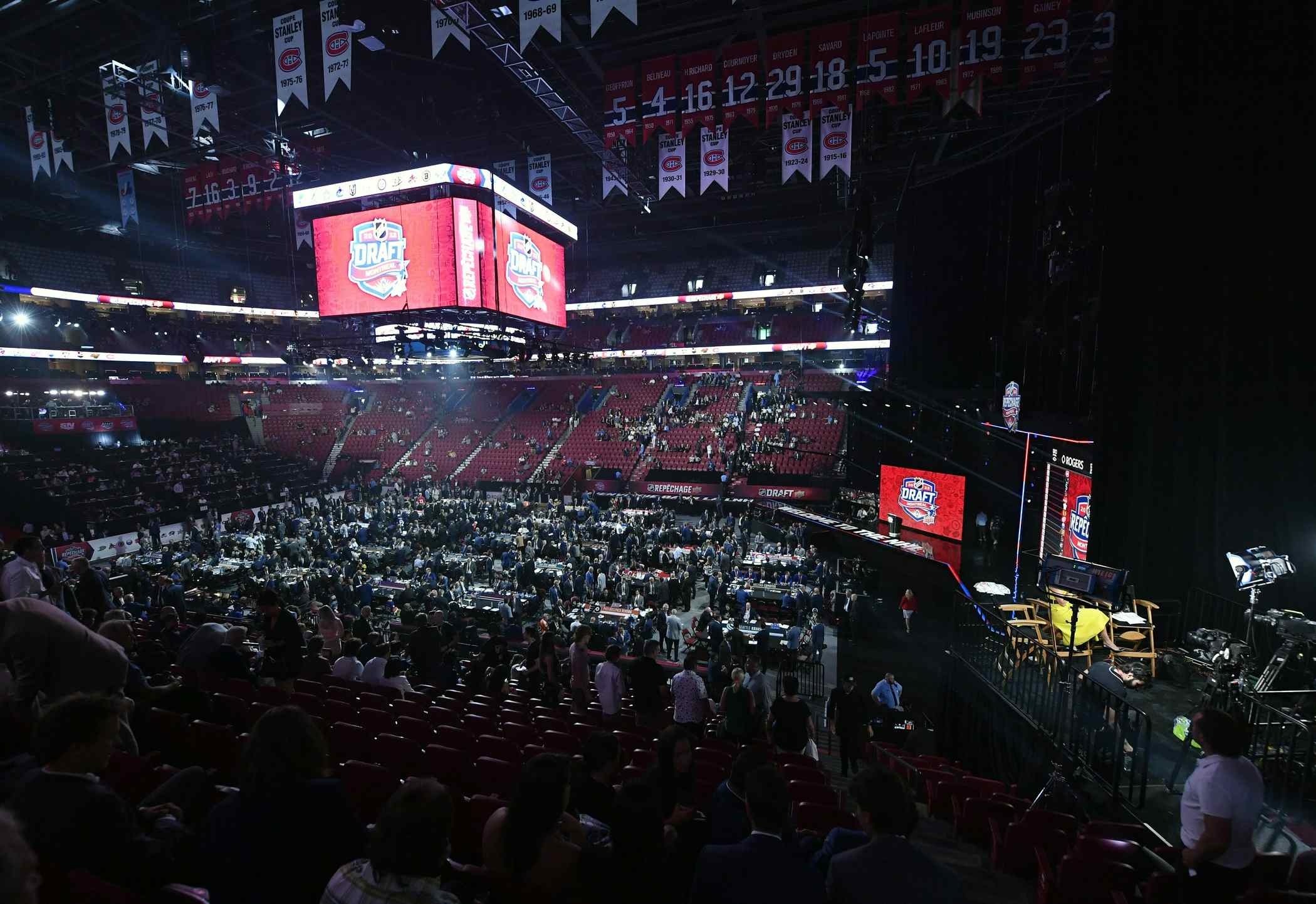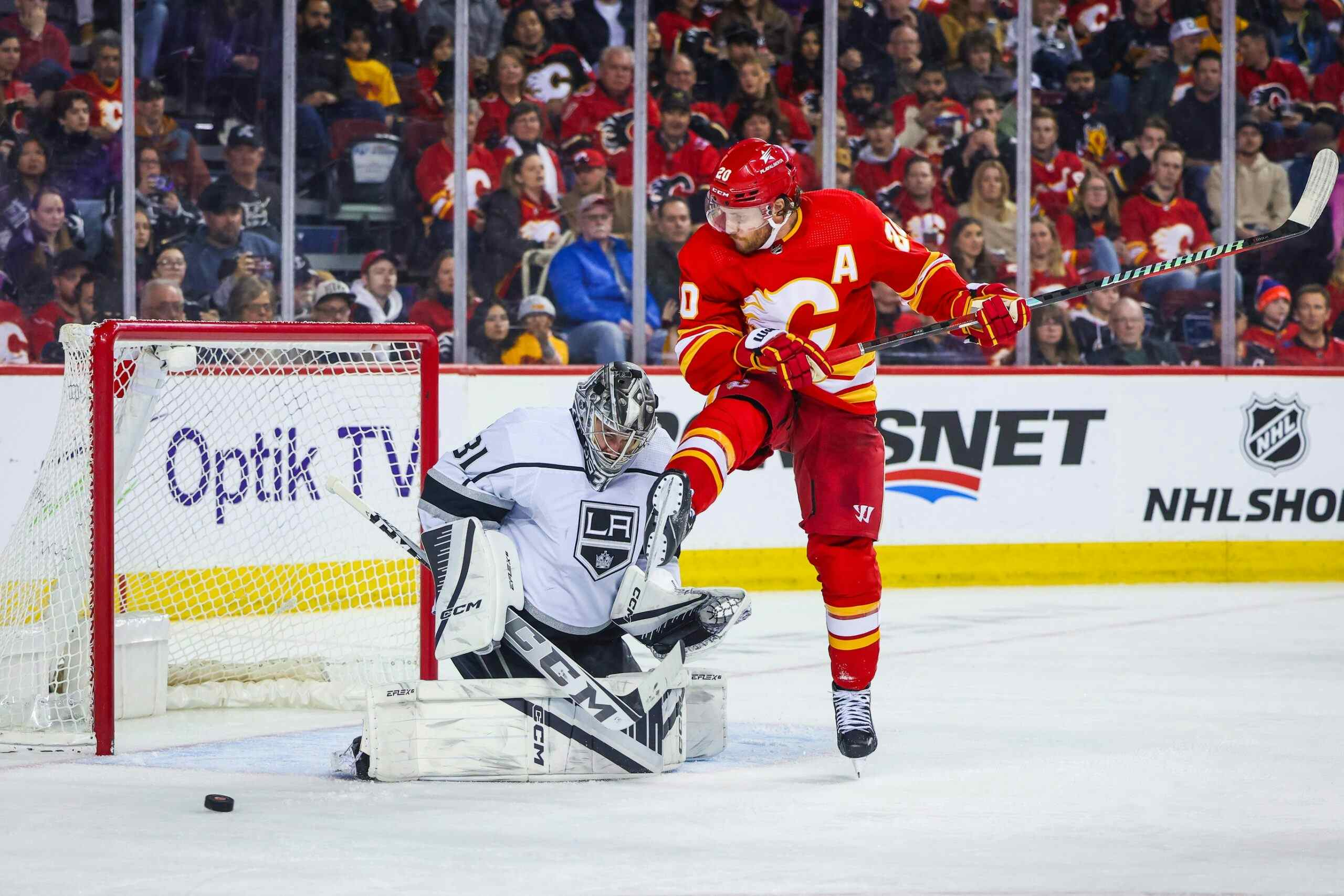How does the Lucic for Neal trade look one year later?
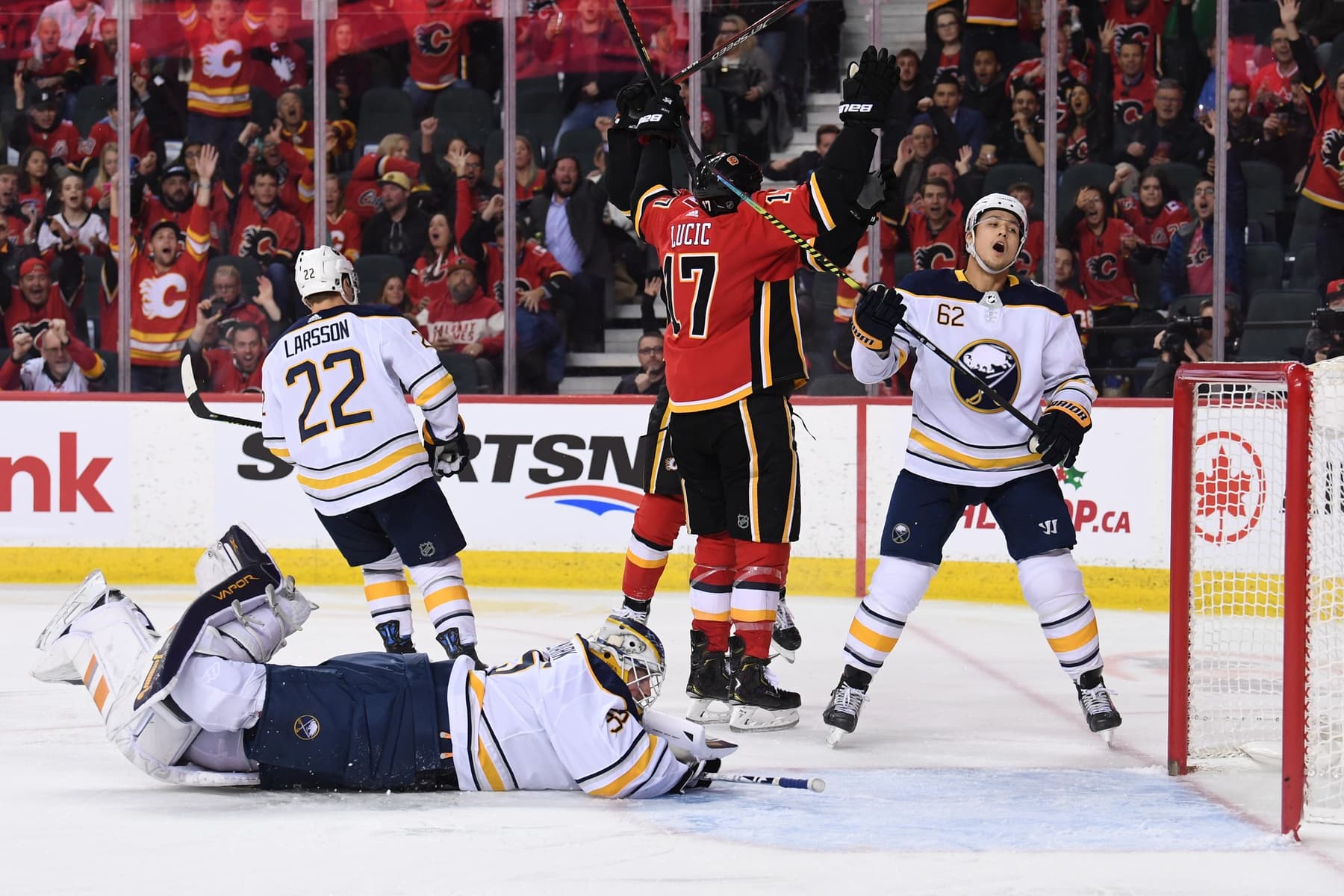
By Mike Wilson
3 years agoWith an assist in Game 1 against the Dallas Stars, Milan Lucic became the first Flame to kick off the post-season with a five game point streak since Jarome Iginla did it back in 2006.
That is not something I thought we’d be hearing when I learned he had been traded to the Flames.
When Brad Treliving’s club announced the acquisition shortly after being run out of town by the speed and skill of the Colorado Avalanche, I was sure we were living in the darkest timeline.
From the player to the fit to the contract implications it looked like a Hail Mary, and a costly one at that, just to be rid of James “The Certainly Not So Real Deal” Neal. Adding a player who was regressing, seriously lacked foot speed, and, even with retained salary, commanded a hefty AAV with a no-move clause (and a bonus-heavy payment structure); it seemed the Flames were the clear loser.
Well, as Michael Scott said: how the turntables turn.
Over a calendar year later the trade has worked out pretty, pretty, pretty good for the Flames.
Lucic hasn’t been the anchor many were sure he was going to be. In fact, he has shown up for the Flames in the post-season in a big way. And honestly, I’ve grown to like him. He’s an intelligent player, has a strong rapport with coach Geoff Ward, and has developed chemistry with his teammates in a way Neal never seemed able to.
Now that the Oilers have been eliminated from playoff qualification and the Flames are up 1-0 on the Stars (in no small part from a strong showing from Lucic) it seems like a good time to reevaluate the trade. I’m sure this will become an annual tradition.
First, let’s compare how each player performed this season. It’s also important to examine, a year later, who extracted the most value from this deal over the 2019-20 season. Finally, as this will undoubtedly be an ongoing discussion, look at future implications.
Let’s dig into the individual contributions of Lucic and Neal this season to their respective clubs.
Individual stats
| James Neal | 2019-20 All Situations | Milan Lucic |
| 55 | GP | 68 |
| 19 | Goals | 8 |
| 4 | Primary Assists | 6 |
| 8 | Secondary Assists | 6 |
| 31 | Points | 20 |
| 7.49 | Shots For / 60 mins | 5.49 |
| 14.32 | Shot Attempts For / 60 mins | 9.53 |
| 15.2 | Individual Expected Goals For | 9.54 |
| 3.8 | Goals Above Expected | -1.54 |
| 16.96 | Shooting % | 9.64 |
(Data from Evolving Hockey; All Situations)
Neal rode some shooting luck this season to hit the 19 goal mark. He outscored his individual expected goals with a career-high in shooting percentage this year at just under 17%. Over his career, Neal has shot 11.9% on average. We’ll give him a slight bit of sympathy here for getting lucky since in his awful, no good season with the Flames he shot a dismal 5%.
Early in the year, it looked as though he was going to make the Flames appear foolish for trading him. He was seemingly scoring at will with 11 goals in his first 14 games with the Oilers. He eventually cooled off and didn’t score a regular-season goal in 2020 – he was sidelined for the whole month of February with an injury, so I won’t rail on him too much.
Lucic took his sweet time in the goal-scoring department. Going without a single goal through the first two months of the season, it looked a bit dire for the Flames and the endless jeering from boastful Oilers fans drunk on the shooting percentage bender power of James Neal was growing tiresome.
Lucic himself was feeling it. Speaking to Scott Oake on After Hours, Lucic had this to say about his rough start to the season:
There was times where the start for me things weren’t going so well… I think after about six, seven weeks into the season I remember playing, the first time we played St. Louis here on a ‘Hockey Night in Canada’ game, I got benched in the third period and nothing was said to me by anyone and I wasn’t really happy about it and I even started questioning whether I should hang them up because it just wasn’t fun for me anymore.
Enter Geoff Ward. In the same interview, Lucic credited the interim head coach with getting him going again.
At the end of the day in saying all that I have to give a lot of credit to Geoff Ward, the other three coaches and all my teammates for sticking with me and keeping me motivated… Especially Gio and Monahan, two guys that I’ve really been close with since I’ve come here. They’ve kept me going and they’ve managed to pump me up, and I talked about Dubes and what it’s meant to play with him and the life he’s given me. So yeah, I’m having fun again, especially playing for Wardo.
After Ward took over the bench the big guy finally got rolling. Lucic broke his slump in December with three goals and finished the year with eight.
Fun fact: the Flames almost went undefeated in games in which Lucic scored. That record was smashed in the final game before the shutdown in a loss to Vegas. They were 7-1-0 when Lucic scored this season.
Failed to load video.
Deployment
One of the main narratives coming out of the trade: Neal wasn’t a fit in the Flames bottom six forward group but he couldn’t manage to crack the top six either.
Lucic had jumped around in the Oilers lineup, toiling away with the likes of Zack Kassian.
The Oilers needed top six scoring and the Flames needed to solidify their bottom six.
It seemed both players were stuck in purgatory in their current situations. Let’s look at how they were deployed this year.
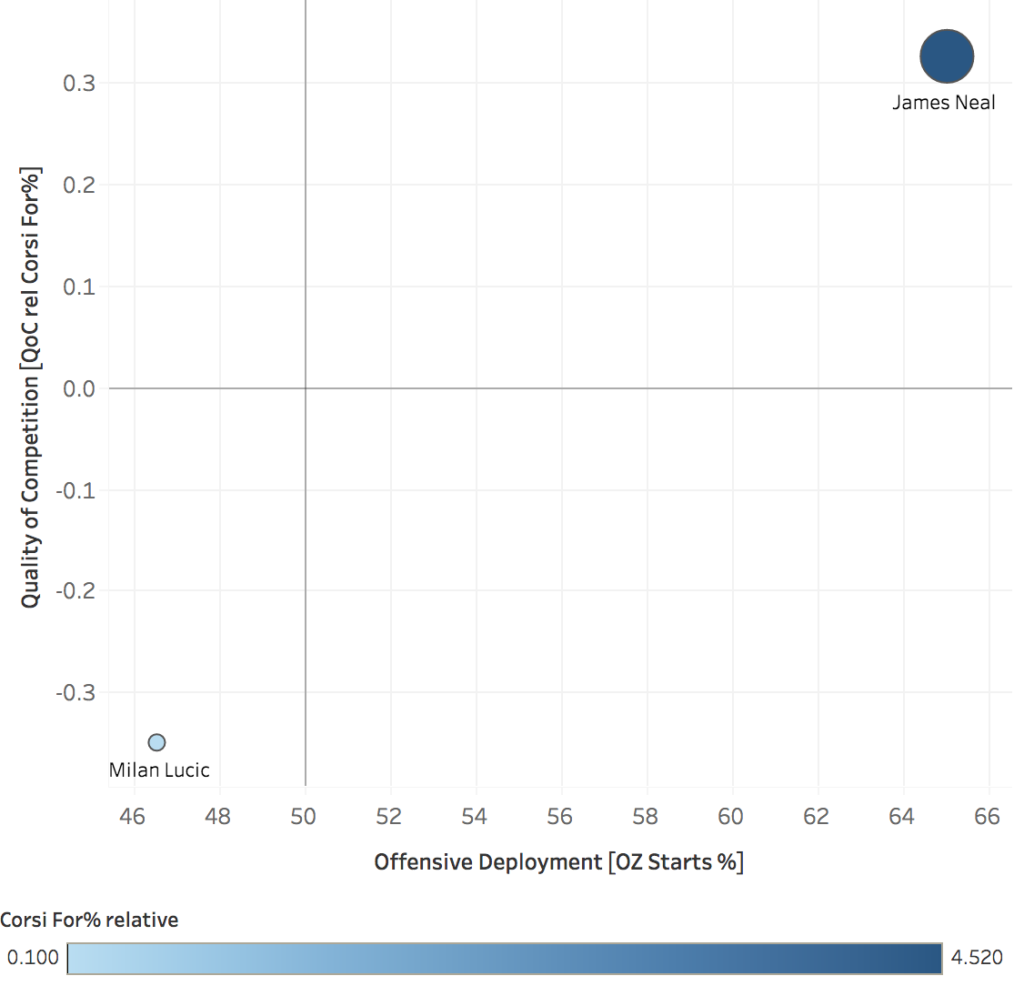
(Chart courtesy Hockey Abstract. Publicly accessible at HockeyAbstract.com)
Using the Player Usage Chart tool from Hockey Abstract we can ascertain two things:
- Neal was heavily utilized in the offensive zone this year with 65.02% of starts. Lucic, in contrast, started more often in the defensive zone being deployed 46.56% of the time in the offensive zone.
- Neal faced tougher competition than Lucic. Intuitively, that makes sense: Neal was inserted into the Oilers top six while Lucic played most of his minutes on Calgary’s third line.
Neal was deployed on the power play (18% of his total TOI was on the PP), saw top six minutes, and tougher opponents. Lucic, meanwhile, has been a mainstay on the third line with more defensive responsibilities.
On ice metrics
Neal and Lucic’s underlying on-ice numbers at 5v5 are very similar.
| James Neal | 5v5 Score & Venue Adjusted | Milan Lucic |
| 50.43 | Corsi For% | 49.70 |
| 40.86 | Goals For% | 51.20 |
| 50.03 | Expected Goals For% | 50.48 |
(Data from Natural Stat Trick)
Neal gets a slight edge in terms of possession (CF%) and Lucic a very slight edge in terms of quality shot share (xGF%). Most noticeably is the discrepancy in goals-for percentage (percentage of total goals for while a player is on the ice).
The power play is where Neal did his work. Again, he did have some luck this season. You can see that his quality shot generation (xGF) was lower than his actual goal rate. This simply means he scored more than he should have based on the quality of his chances.
Lucic was actually alright on the Flames power play but Neal produced more offense for the Oilers on the man advantage.
| James Neal | Power Play Offense Rate Per 60 Min | Milan Lucic |
| 10.99 | Goals For/60 | 6.61 |
| 7.86 | Expected Goals For/60 | 6.40 |
(Data from Natural Stat Trick)
Isolated impact
To get a clearer picture of individual impact, we can use Micah Blake McCurdy’s model to isolate shot rates when Neal and Lucic were on the ice this season. McCurdy’s model, found on HockeyViz.com, attempts to completely isolate a single player’s impact in terms of offense and defense.
The ‘threat’ model accounts for every variable you can conceive of (teammates, score effects, schedule) and uses regression to estimate the isolated impact of the player.
5 on 5
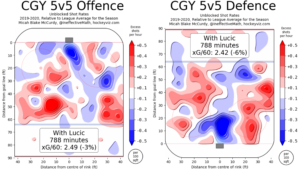

(Chart courtesy HockeyViz. Publicly accessible at Hockeyviz.com)
According to isolated shot rates, when Lucic was on the ice this season, he was below average – by three percentage points – in driving up the chances of a Flames goal. In terms of defending, it should be noted that the negative is a good thing. With Lucic, the opposing team was 6% less of a threat to score a goal compared to the NHL average when playing the Flames.
Neal’s isolated offensive impact was below average at a negative 7%. On the defensive side, the opposing team was 3% less of a threat to score a goal compared to the NHL average with him on the ice.
Based on isolated impact, Lucic was the better play driver this season.
In the aggregate (combining both impact percentages) the Flames performed 3% better in terms of driving play with Lucic on the ice. Neal’s total isolated impact for the Oilers: negative 4%.
Power play
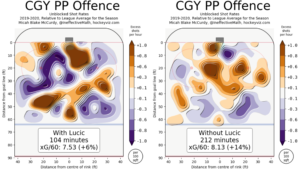
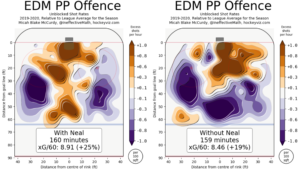
(Chart courtesy Hockey Viz. Publically accessible at Hockeyviz.com)
The isolated impact charts show the Oilers’ power play was more of a threat to score by 6 percentage points with Neal on the ice. As for Lucic, his impact was positive but without him, the power play jumped from 7.53 expected goals per 60 minutes to 8.13.
In summation: Lucic gets the edge both offensively and defensively at 5v5 due to slightly better metrics in goal share and quality shot share.
Neal gets the edge on the PP for helping boost an already deadly Oilers’ unit.
Value
There’s no way of knowing, from an off ice perspective, what went down behind closed doors last year with James Neal.
Rumours swirl, legends grow, the old “toxic in the room” cliche (true or not) gets thrown around. We’ll never be able to fully know any of that until one of James Neal, Milan Lucic, or Rasmus Andersson pens a tell-all 20 years down the line.
What we can attempt to discern is: did the Flames forward group improve with Lucic?
The Flames acquired a player who, for this year at least, added an element they deemed lacking (toughness), had similar and, in some cases, better play driving numbers, and has been difference-maker at the most important junction of the season.
Did Lucic perform above expectations? In the latter part of the Flames season, maybe.
In the post-season (so far)? No doubt.
He faced some criticism for being a physical non-factor in highly contested games, specifically in games against his former club. I was actually impressed with how he handled that part of his game. He picked his spots (a suspension notwithstanding). He wasn’t running around all year trying to prove his toughness. From a purely on-ice perspective, give me Lucic all day.
Also consider the Flames were able to trim a precious $500,000 against the cap in the swap in a year where they needed to sign important RFA’s (Tkachuk, Mangiapane).
Throw in the fact they will receive the conditional third round draft pick (depending on Edmonton’s choice this may be the pick going to Chicago for Erik Gustafsson).
So, everything weighed: the Flames have extracted the most value from this deal as of August 2020.
Failed to load video.
Future considerations
The Lucic-Bennett-Dube line has been dynamite in the playoffs. (To be fair, Neal was fine in the Oilers series, but they just happened to lose. Oilers gonna oil). The 29-93-17 unit has shown some serious chemistry in the qualifying round and it has carried over into Round 1 as the trio was integral in the Flames 3-2 victory in Game 1.
Just as we were promised: he is helping the Flames win in the playoffs.
Alright, onto the larger picture.
There is no getting around the fact that the contract is still bad both in terms of dollar and length. Lucic is certainly coming up huge right now but it’s never ideal to be allocating that high a dollar figure/term to a bottom six forward who put up 20 regular season points. I would assume, based on pre-pandemic cap projections, the Flames thought they were looking at a significant rise in the salary cap.
That will not be the case and the cap will remain flat for the near future.
Lucic’s $5.25 million AAV will come off the books in 2023. Due to the structure of his deal, a buyout would not give the Flames much relief for years one and two. Again, the big guy is playing exceptionally well right now, but a few seasons down the road the situation could be different.
Also, after a string of buyouts (notably Bouma, Brouwer, and Stone), I’m sure ownership isn’t too keen on allocating more dough for that purpose.
As per PuckPedia, if the Flames did elect to buy Lucic out after next season the savings would be minimal in the first two seasons. Regardless, how Lucic’s share of the salary structure impacts the Flames over the next few years will continue to alter how this trade is viewed.

(from PuckPedia)
It can certainly be a killer to have that much money tied up in a bottom-six player. Let’s face it: paying that much money to a player who put up 8 goals over the season and who has regressed so noticeably, especially in terms of footspeed over the years, is still problematic.
Finally, there is the issue of the no-movement clause.
As per the NMC, the Flames would be required to protect Lucic in the upcoming Seattle expansion draft. He can waive and elect to be exposed, but it is within his rights to refuse to waive if asked.
Again, how this plays out will affect how we view the trade. If the Flames end up losing a valuable player being forced to protect Lucic… we might not be as happy.
The resurgence of Milan Lucic
As for this chapter of the Neal/Lucic saga: one team is a draft pick richer, $500,000 lighter and, most importantly, playing playoff hockey. The other team is at home. Lucic has found a part of his game we assumed was long gone. And I’m here for it.
Maybe you have always viewed this trade as a positive; I’m certainly more than happy to eat a bunch of crow and tell you I was always skeptical. I’m still feeling trepidatious about future implications. A full year later I can tell you two things:
- I’m blown away by the positive contributions of Milan Lucic so far in the playoffs.
- I’m super happy for him.
How is everyone feeling about Looch now?
Recent articles from Mike Wilson




